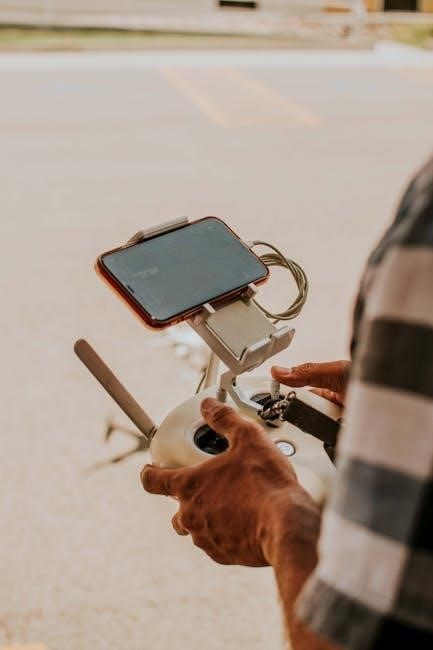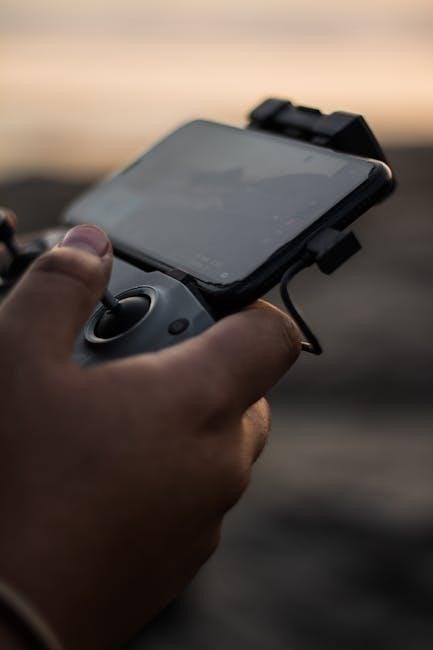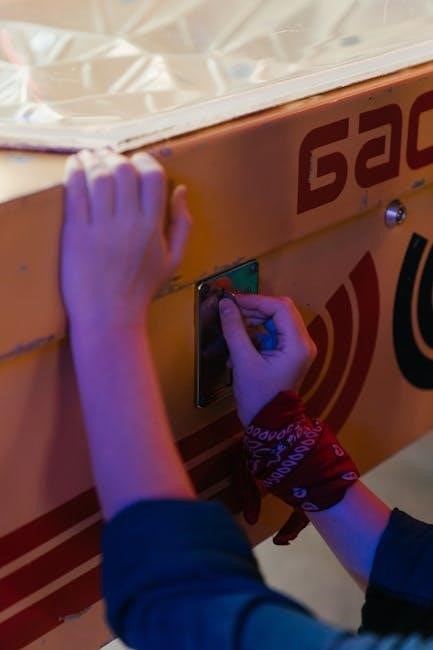Safety Information
Always turn off the radio in areas with posted restrictions. Avoid using damaged antennas or batteries. Use only BAOFENG-approved chargers and accessories to ensure safe operation.
1.1. General Safety Precautions
Do not modify the radio or use unauthorized accessories. Keep the device away from water and extreme temperatures. Avoid exposing the antenna to metal objects. Turn off the radio during thunderstorms or emergencies. Ensure the battery is handled properly to prevent damage. Follow all local regulations and airline instructions when using the device.
1.2. Battery and Charger Safety
Use only BAOFENG-supplied or approved batteries and chargers. Avoid overcharging, which can cause damage or overheating. Do not charge near flammable materials. If the battery is damaged, discontinue use immediately. Store batteries in a cool, dry place away from metal objects. Never attempt to modify or repair the battery pack yourself.
1.3. Antenna Usage Guidelines
Use only the supplied or BAOFENG-approved antennas. Avoid using damaged or bent antennas, as this can cause performance issues or damage the radio. Do not touch the antenna during transmission to prevent interference. Keep the antenna away from conductive materials. For optimal performance, use the antenna in an open area. Turn off the radio when boarding an aircraft or in areas with specific restrictions.
Features and Functions
Dual-band VHF/UHF transceiver with customizable display, CTCSS/DCS tone settings, and emergency SOS signal. Supports programmable memory channels and adjustable frequency steps for versatile communication needs.
2.1. Dual-Band Operation (VHF/UHF)
The Baofeng UV-5R supports dual-band operation, covering VHF (136-174MHz) and UHF (400-520MHz) frequencies. This allows communication across a wide range of environments and applications. The radio enables seamless switching between bands, ensuring versatile operation for both amateur and professional use. Its wide band coverage and programmable memory channels make it ideal for diverse communication needs.
2.2. CTCSS and DCS Tone Settings
The Baofeng UV-5R supports both CTCSS (Continuous Tone-Coded Squelch System) and DCS (Digital-Coded Squelch) tones. These settings allow users to filter communications, ensuring only specific calls are received. CTCSS tones are analog, while DCS tones are digital, providing enhanced privacy and group communication control. Users can program tones via the menu or PC software for tailored radio operation.
2.3. Customizable Display and Tones
The Baofeng UV-5R features a customizable LCD display, allowing users to adjust backlight colors for transmit, receive, and standby modes. The display shows frequency, offset, and tone settings. Users can also customize tones for various operations, such as power-on messages and alerts, enhancing personalization and operational convenience. These settings can be programmed via the menu or PC software for a tailored experience.

Unpacking and Checking Equipment
Verify the package includes the radio, antenna, battery pack, charger, and manual. Inspect all items for damage or defects before initial use.
3.1. Items Included in the Package
The package includes the Baofeng UV-5R radio, an antenna, rechargeable battery pack, charger, belt clip, and user manual. Some packages may also include a programming cable or earpiece. Verify all items are present and undamaged before use.
3.2. Verifying the Condition of the Radio
Inspect the radio for any visible damage. Ensure the LCD display is intact and functional. Turn on the radio to test basic functions like power-on and display brightness. Verify the antenna is securely attached and undamaged. Check the battery for proper installation and charge. Ensure all buttons and knobs operate smoothly before first use.

Installation of Accessories
Install the antenna securely to ensure proper signal reception. Attach the battery pack correctly, aligning the contacts. Follow the manual for accessory installation guidelines.
4.1. Installing the Antenna
To install the antenna, align it with the radio’s antenna port and twist clockwise until securely locked. Ensure the antenna is fully seated to avoid signal loss. For optimal performance, use the provided high-gain antenna. Avoid forcing the connection to prevent damage. Regularly inspect the antenna for damage or wear. Replace damaged antennas immediately to maintain proper functionality.
4.2. Attaching the Battery Pack
Align the battery pack with the radio’s back, ensuring the contacts match. Gently push and slide upward until it clicks securely. Avoid using damaged batteries or unauthorized chargers. Charge only with BAOFENG-approved adapters to prevent overheating or damage. Regularly inspect the battery for wear and replace if necessary for optimal performance and safety.

Menu Navigation and Settings
Navigate through menus using the up/down buttons. Set frequency steps, CTCSS/DCS tones, and customize display options. Use the menu to access advanced features like SOS signals and repeater tones.
5.1. Navigating the Menu System
Access the menu by pressing the Menu button. Use the up/down arrows to scroll through options. Press Menu again to select an item and adjust settings. Press Exit to return to the main screen. This system allows efficient customization of features like frequency steps, tones, and display settings. Experiment with options to familiarize yourself with the interface, and refer to the manual for detailed guidance on complex settings.
5.2. Setting the Frequency Step (STEP)
Press Menu and scroll to STEP using the up/down arrows. Select the desired step size (e.g., 2.5, 5, or 10 kHz) using the same buttons. Press Menu to confirm. The STEP setting determines the tuning increment in VFO mode, allowing precise frequency adjustments. This feature is crucial for accurate channel tuning and optimal communication performance across different frequency bands.

Channel Programming
Program channels in VFO mode by setting the frequency, offset, and tone. Save to memory for quick access. Use CTCSS/DCS tones for secure communication.
6.1. Programming Channels in VFO Mode
Enter VFO mode and select the desired frequency using the keypad. Set the offset direction and tone via the menu. Save the configuration to a memory channel for quick access. This allows easy retrieval of frequently used frequencies and settings.
6.2. Using Memory Channels (MR)
Memory channels allow quick access to frequently used frequencies. Press MR to activate memory mode. Use the keypad to recall stored channels. Edit or delete channels as needed. This feature streamlines operation, ensuring efficient communication by saving your most-used settings.

Advanced Features
The Baofeng UV-5R includes advanced features like SOS emergency signaling and a 1750Hz tone for repeater access. These functions enhance communication efficiency and safety in critical situations.
7.1. SOS Emergency Signal
The SOS emergency signal feature on the Baofeng UV-5R activates when the PTT button is held for a long press, emitting a high-pitched tone through the speaker and transmitting an alert to other users. This function is designed for critical situations, ensuring quick notification and assistance when needed. Proper training is recommended for its effective use.
7.2. 1750Hz Tone for Repeater Access
The 1750Hz tone is required for accessing certain repeaters. Enable this tone in the menu system under the “1750Hz Tone” option. When activated, the radio transmits a 1750Hz tone during transmission, allowing compatibility with repeaters that require this specific tone for access. Ensure the feature is properly configured for reliable communication with compatible systems. Consult the manual for detailed activation steps.
Troubleshooting Common Issues
Check battery and antenna connections for proper functionality. Ensure the radio is powered on and volume is adjusted. For poor reception, verify signal strength and antenna condition.
8.1. No Power or Display Issues
Check if the battery is fully charged and properly connected. Ensure the power switch is turned on. Verify that the battery pack is not damaged. If the display is dark, adjust the backlight settings or reset the device. Ensure no firmware glitches by performing a factory reset if necessary.
8.2. Poor Reception or Transmission Quality
If experiencing poor reception or transmission quality, ensure the antenna is securely attached and undamaged. Move to an open area to improve signal strength. Adjust the squelch and sensitivity settings to optimize performance. Use CTCSS or DCS tones to reduce interference. Check for nearby devices causing interference and reposition the antenna if necessary.

Maintenance and Care
Regularly clean the exterior and display with a soft cloth and mild detergent. Use original chargers to prevent battery damage. Avoid extreme temperatures and humidity to maintain optimal performance.
9.1. Cleaning the Radio
Use a soft, dry cloth to wipe the exterior and display. For stubborn dirt, dampen the cloth with mild detergent, but avoid harsh chemicals. Never soak the radio or use abrasive materials. Clean the antenna and connectors with a dry cloth to ensure proper signal transmission. Regular cleaning prevents dust buildup and maintains optimal performance.
9.2. Updating Firmware (if applicable)
Regular firmware updates ensure optimal performance and fix bugs. Download the latest version from BAOFENG’s official website. Use BAOFENG PC software to update the firmware. Connect the radio to your computer, select the firmware file, and follow on-screen instructions. The update process retains all settings. After completion, restart the radio to apply changes; Always verify firmware compatibility before installation.

Compatibility and Accessories
Ensure compatibility with BAOFENG-approved accessories for optimal performance. Use genuine batteries, chargers, and antennas. PC software is available for advanced customization and firmware updates.
10.1. Compatible Accessories
The BAOFENG UV-5R supports a variety of compatible accessories, including high-gain antennas for improved reception, external speakers for enhanced audio, and programmable buttons for custom functionality. Additionally, it works seamlessly with BAOFENG-supplied batteries and chargers, ensuring reliable power. For advanced users, PC software and programming cables are available to customize settings and update firmware, maximizing the radio’s potential.
10.2. Using PC Software for Customization
Use the BAOFENG PC software to customize your UV-5R, enabling adjustments to display colors, tones, and memory channels. The software, available for download from the official website, allows users to personalize settings and update firmware. A programming cable is required for connectivity. This tool enhances functionality and ensures your radio meets specific communication needs, offering advanced customization options for optimal performance.


